Clinical Reasoning: Analyzing a Clinical Decision Using CRC Stages
VerifiedAdded on 2023/06/10
|7
|1513
|200
Essay
AI Summary
This essay delves into the application of the clinical reasoning cycle to a clinical practice scenario encountered during an orthopedic ward placement. The case involves Sandra, a 58-year-old woman with osteoarthritis, whose condition deteriorated following the loss of her husband. The essay meticulously applies the seven stages of the clinical reasoning cycle—considering the patient situation, collecting cues, processing information, identifying the issue, establishing goals, taking action, and evaluating outcomes—to analyze the clinical decision-making process. The analysis reveals the impact of lifestyle choices, trauma, and medication adherence on Sandra's osteoarthritis management. The intervention plan includes patient education, dietician and physiotherapist consultations, medication routine development, and psychotherapy referral. The essay concludes by highlighting the importance of the clinical reasoning cycle in understanding and addressing patient care needs, emphasizing the potential for improved clinical decision-making in future practice scenarios. The student document is available on Desklib, a platform providing study tools for students.
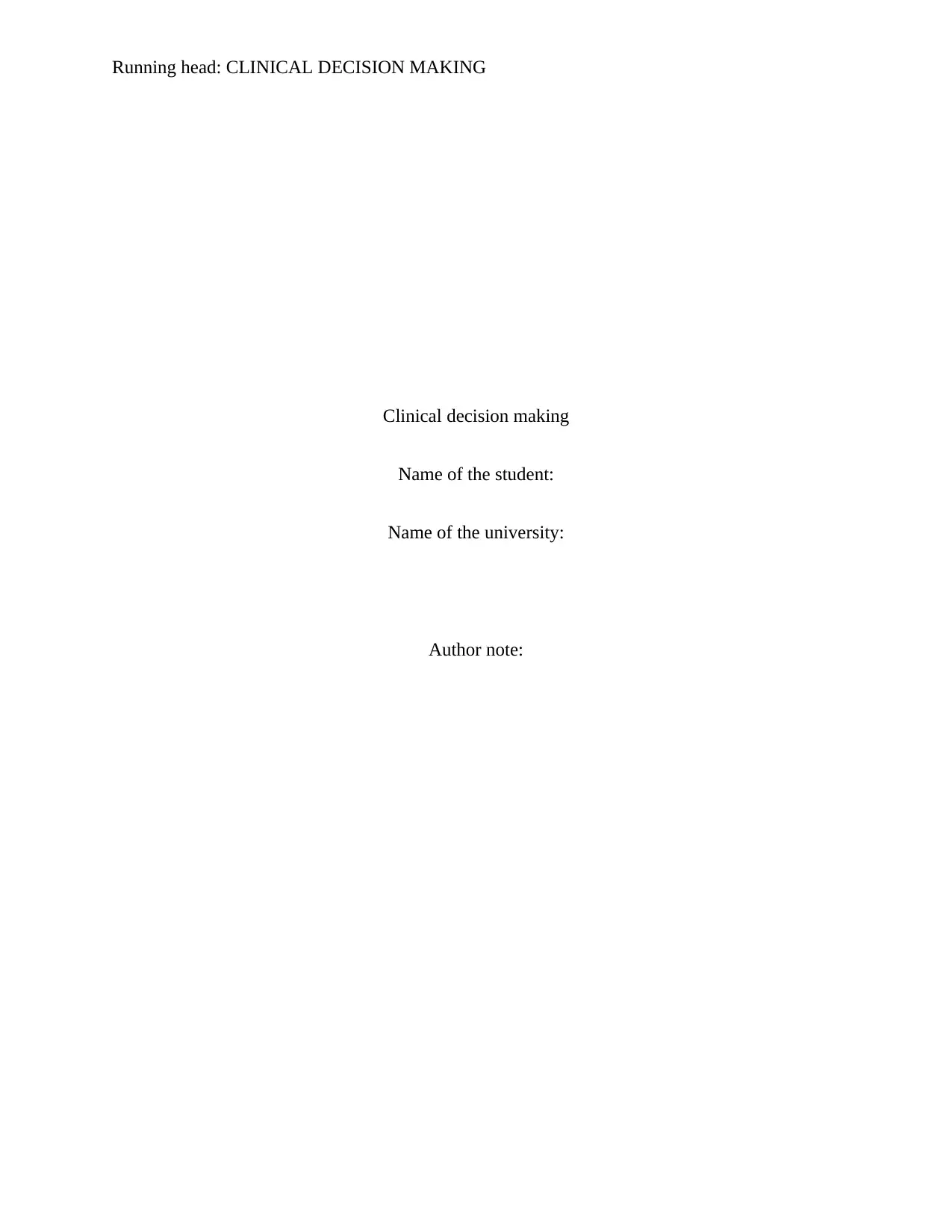
Running head: CLINICAL DECISION MAKING
Clinical decision making
Name of the student:
Name of the university:
Author note:
Clinical decision making
Name of the student:
Name of the university:
Author note:
Paraphrase This Document
Need a fresh take? Get an instant paraphrase of this document with our AI Paraphraser
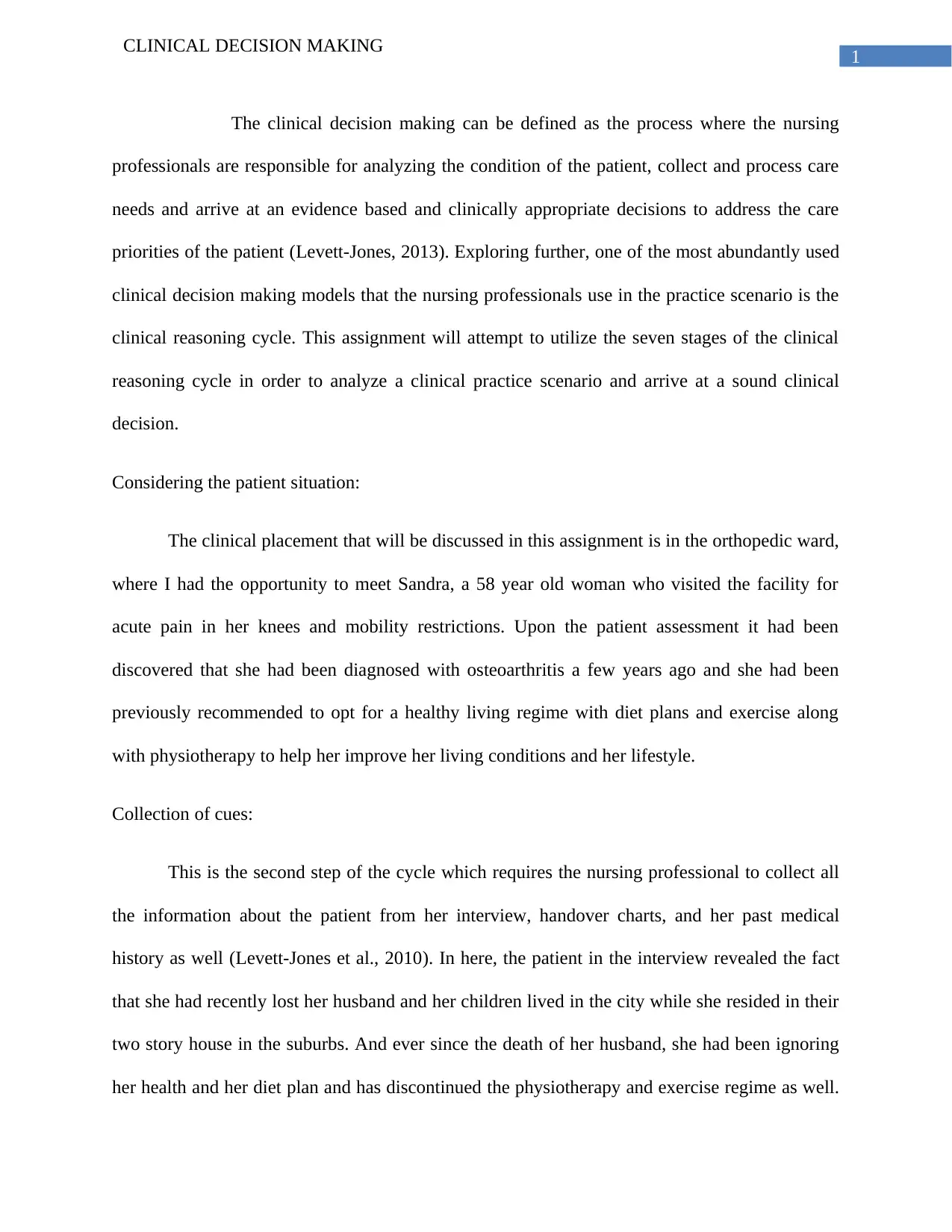
1
CLINICAL DECISION MAKING
The clinical decision making can be defined as the process where the nursing
professionals are responsible for analyzing the condition of the patient, collect and process care
needs and arrive at an evidence based and clinically appropriate decisions to address the care
priorities of the patient (Levett-Jones, 2013). Exploring further, one of the most abundantly used
clinical decision making models that the nursing professionals use in the practice scenario is the
clinical reasoning cycle. This assignment will attempt to utilize the seven stages of the clinical
reasoning cycle in order to analyze a clinical practice scenario and arrive at a sound clinical
decision.
Considering the patient situation:
The clinical placement that will be discussed in this assignment is in the orthopedic ward,
where I had the opportunity to meet Sandra, a 58 year old woman who visited the facility for
acute pain in her knees and mobility restrictions. Upon the patient assessment it had been
discovered that she had been diagnosed with osteoarthritis a few years ago and she had been
previously recommended to opt for a healthy living regime with diet plans and exercise along
with physiotherapy to help her improve her living conditions and her lifestyle.
Collection of cues:
This is the second step of the cycle which requires the nursing professional to collect all
the information about the patient from her interview, handover charts, and her past medical
history as well (Levett-Jones et al., 2010). In here, the patient in the interview revealed the fact
that she had recently lost her husband and her children lived in the city while she resided in their
two story house in the suburbs. And ever since the death of her husband, she had been ignoring
her health and her diet plan and has discontinued the physiotherapy and exercise regime as well.
CLINICAL DECISION MAKING
The clinical decision making can be defined as the process where the nursing
professionals are responsible for analyzing the condition of the patient, collect and process care
needs and arrive at an evidence based and clinically appropriate decisions to address the care
priorities of the patient (Levett-Jones, 2013). Exploring further, one of the most abundantly used
clinical decision making models that the nursing professionals use in the practice scenario is the
clinical reasoning cycle. This assignment will attempt to utilize the seven stages of the clinical
reasoning cycle in order to analyze a clinical practice scenario and arrive at a sound clinical
decision.
Considering the patient situation:
The clinical placement that will be discussed in this assignment is in the orthopedic ward,
where I had the opportunity to meet Sandra, a 58 year old woman who visited the facility for
acute pain in her knees and mobility restrictions. Upon the patient assessment it had been
discovered that she had been diagnosed with osteoarthritis a few years ago and she had been
previously recommended to opt for a healthy living regime with diet plans and exercise along
with physiotherapy to help her improve her living conditions and her lifestyle.
Collection of cues:
This is the second step of the cycle which requires the nursing professional to collect all
the information about the patient from her interview, handover charts, and her past medical
history as well (Levett-Jones et al., 2010). In here, the patient in the interview revealed the fact
that she had recently lost her husband and her children lived in the city while she resided in their
two story house in the suburbs. And ever since the death of her husband, she had been ignoring
her health and her diet plan and has discontinued the physiotherapy and exercise regime as well.
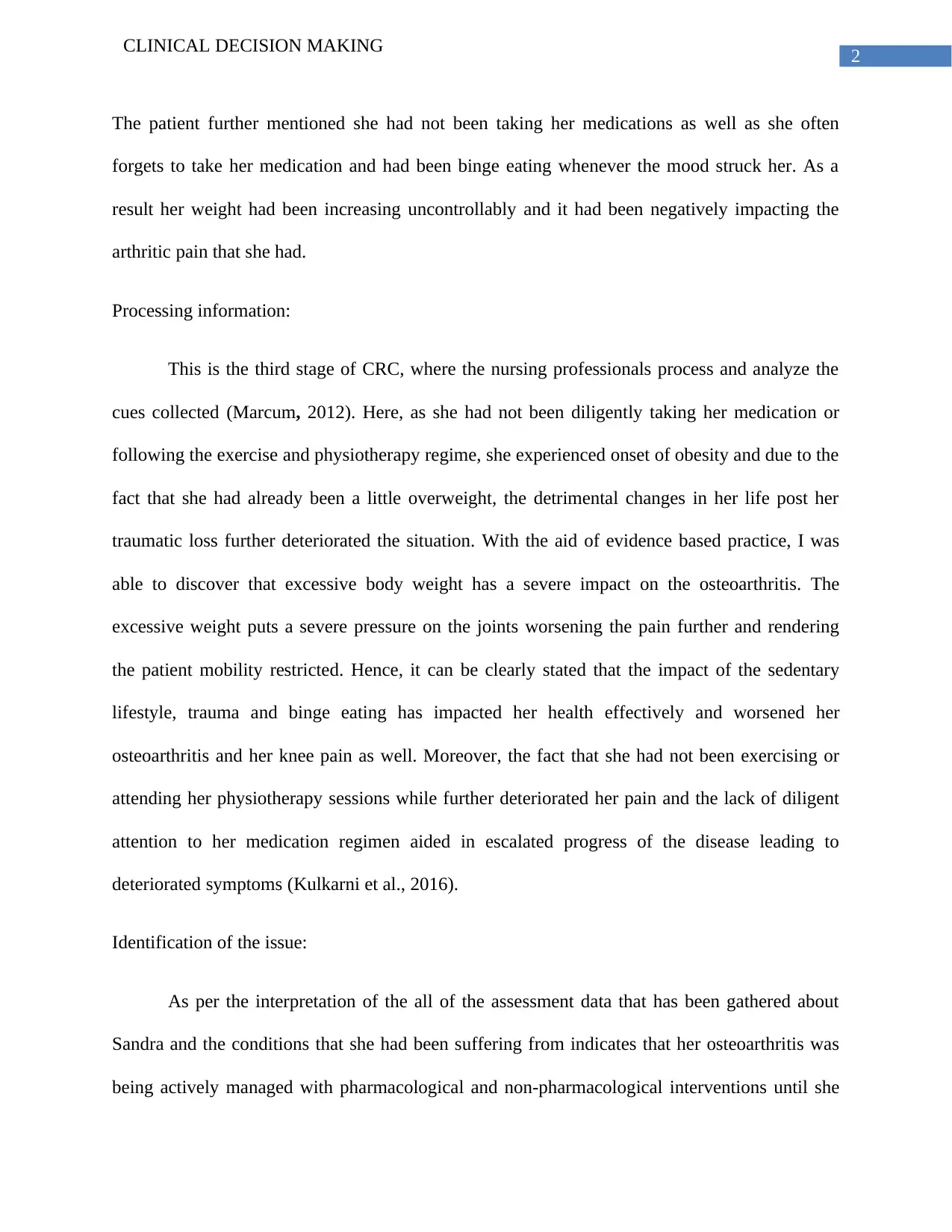
2
CLINICAL DECISION MAKING
The patient further mentioned she had not been taking her medications as well as she often
forgets to take her medication and had been binge eating whenever the mood struck her. As a
result her weight had been increasing uncontrollably and it had been negatively impacting the
arthritic pain that she had.
Processing information:
This is the third stage of CRC, where the nursing professionals process and analyze the
cues collected (Marcum, 2012). Here, as she had not been diligently taking her medication or
following the exercise and physiotherapy regime, she experienced onset of obesity and due to the
fact that she had already been a little overweight, the detrimental changes in her life post her
traumatic loss further deteriorated the situation. With the aid of evidence based practice, I was
able to discover that excessive body weight has a severe impact on the osteoarthritis. The
excessive weight puts a severe pressure on the joints worsening the pain further and rendering
the patient mobility restricted. Hence, it can be clearly stated that the impact of the sedentary
lifestyle, trauma and binge eating has impacted her health effectively and worsened her
osteoarthritis and her knee pain as well. Moreover, the fact that she had not been exercising or
attending her physiotherapy sessions while further deteriorated her pain and the lack of diligent
attention to her medication regimen aided in escalated progress of the disease leading to
deteriorated symptoms (Kulkarni et al., 2016).
Identification of the issue:
As per the interpretation of the all of the assessment data that has been gathered about
Sandra and the conditions that she had been suffering from indicates that her osteoarthritis was
being actively managed with pharmacological and non-pharmacological interventions until she
CLINICAL DECISION MAKING
The patient further mentioned she had not been taking her medications as well as she often
forgets to take her medication and had been binge eating whenever the mood struck her. As a
result her weight had been increasing uncontrollably and it had been negatively impacting the
arthritic pain that she had.
Processing information:
This is the third stage of CRC, where the nursing professionals process and analyze the
cues collected (Marcum, 2012). Here, as she had not been diligently taking her medication or
following the exercise and physiotherapy regime, she experienced onset of obesity and due to the
fact that she had already been a little overweight, the detrimental changes in her life post her
traumatic loss further deteriorated the situation. With the aid of evidence based practice, I was
able to discover that excessive body weight has a severe impact on the osteoarthritis. The
excessive weight puts a severe pressure on the joints worsening the pain further and rendering
the patient mobility restricted. Hence, it can be clearly stated that the impact of the sedentary
lifestyle, trauma and binge eating has impacted her health effectively and worsened her
osteoarthritis and her knee pain as well. Moreover, the fact that she had not been exercising or
attending her physiotherapy sessions while further deteriorated her pain and the lack of diligent
attention to her medication regimen aided in escalated progress of the disease leading to
deteriorated symptoms (Kulkarni et al., 2016).
Identification of the issue:
As per the interpretation of the all of the assessment data that has been gathered about
Sandra and the conditions that she had been suffering from indicates that her osteoarthritis was
being actively managed with pharmacological and non-pharmacological interventions until she
⊘ This is a preview!⊘
Do you want full access?
Subscribe today to unlock all pages.

Trusted by 1+ million students worldwide
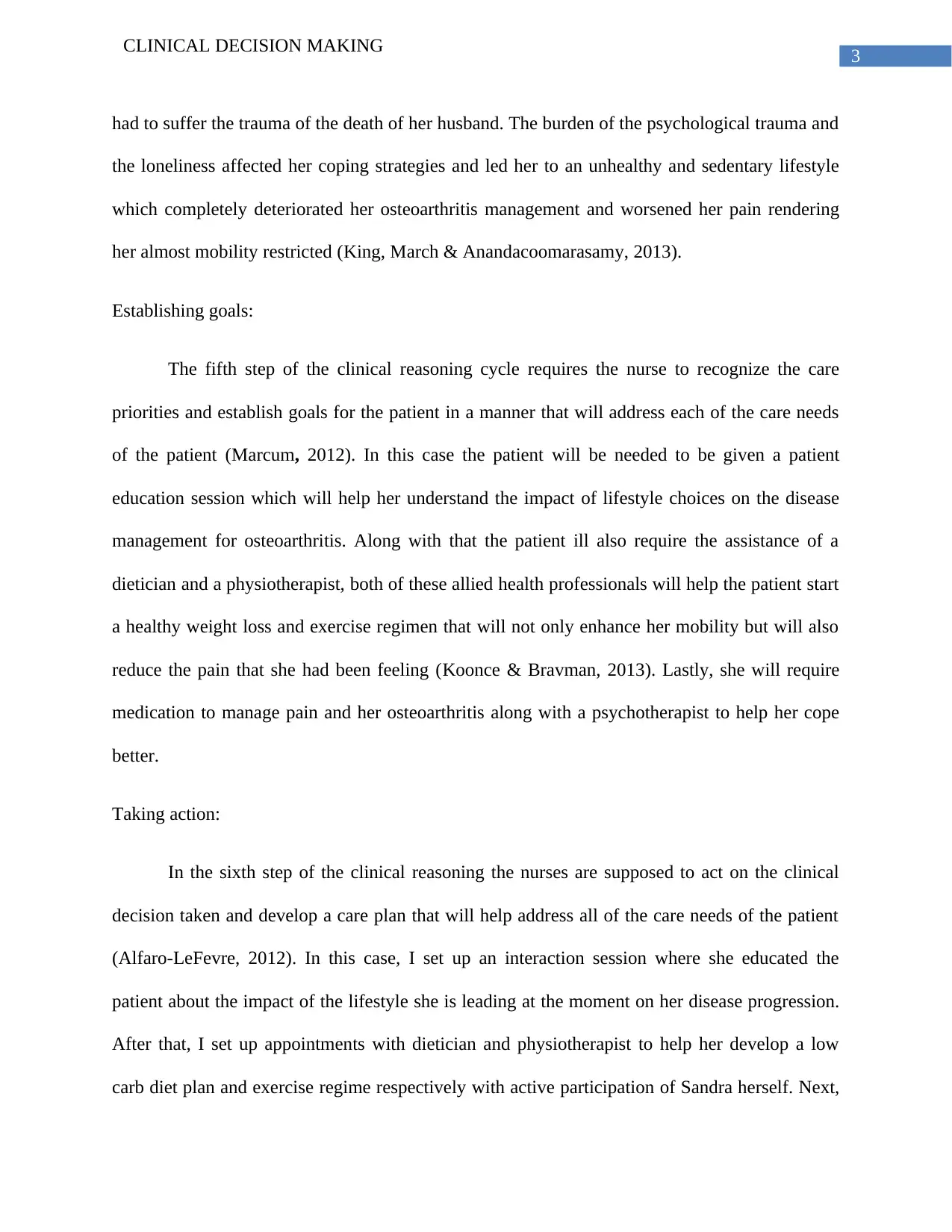
3
CLINICAL DECISION MAKING
had to suffer the trauma of the death of her husband. The burden of the psychological trauma and
the loneliness affected her coping strategies and led her to an unhealthy and sedentary lifestyle
which completely deteriorated her osteoarthritis management and worsened her pain rendering
her almost mobility restricted (King, March & Anandacoomarasamy, 2013).
Establishing goals:
The fifth step of the clinical reasoning cycle requires the nurse to recognize the care
priorities and establish goals for the patient in a manner that will address each of the care needs
of the patient (Marcum, 2012). In this case the patient will be needed to be given a patient
education session which will help her understand the impact of lifestyle choices on the disease
management for osteoarthritis. Along with that the patient ill also require the assistance of a
dietician and a physiotherapist, both of these allied health professionals will help the patient start
a healthy weight loss and exercise regimen that will not only enhance her mobility but will also
reduce the pain that she had been feeling (Koonce & Bravman, 2013). Lastly, she will require
medication to manage pain and her osteoarthritis along with a psychotherapist to help her cope
better.
Taking action:
In the sixth step of the clinical reasoning the nurses are supposed to act on the clinical
decision taken and develop a care plan that will help address all of the care needs of the patient
(Alfaro-LeFevre, 2012). In this case, I set up an interaction session where she educated the
patient about the impact of the lifestyle she is leading at the moment on her disease progression.
After that, I set up appointments with dietician and physiotherapist to help her develop a low
carb diet plan and exercise regime respectively with active participation of Sandra herself. Next,
CLINICAL DECISION MAKING
had to suffer the trauma of the death of her husband. The burden of the psychological trauma and
the loneliness affected her coping strategies and led her to an unhealthy and sedentary lifestyle
which completely deteriorated her osteoarthritis management and worsened her pain rendering
her almost mobility restricted (King, March & Anandacoomarasamy, 2013).
Establishing goals:
The fifth step of the clinical reasoning cycle requires the nurse to recognize the care
priorities and establish goals for the patient in a manner that will address each of the care needs
of the patient (Marcum, 2012). In this case the patient will be needed to be given a patient
education session which will help her understand the impact of lifestyle choices on the disease
management for osteoarthritis. Along with that the patient ill also require the assistance of a
dietician and a physiotherapist, both of these allied health professionals will help the patient start
a healthy weight loss and exercise regimen that will not only enhance her mobility but will also
reduce the pain that she had been feeling (Koonce & Bravman, 2013). Lastly, she will require
medication to manage pain and her osteoarthritis along with a psychotherapist to help her cope
better.
Taking action:
In the sixth step of the clinical reasoning the nurses are supposed to act on the clinical
decision taken and develop a care plan that will help address all of the care needs of the patient
(Alfaro-LeFevre, 2012). In this case, I set up an interaction session where she educated the
patient about the impact of the lifestyle she is leading at the moment on her disease progression.
After that, I set up appointments with dietician and physiotherapist to help her develop a low
carb diet plan and exercise regime respectively with active participation of Sandra herself. Next,
Paraphrase This Document
Need a fresh take? Get an instant paraphrase of this document with our AI Paraphraser
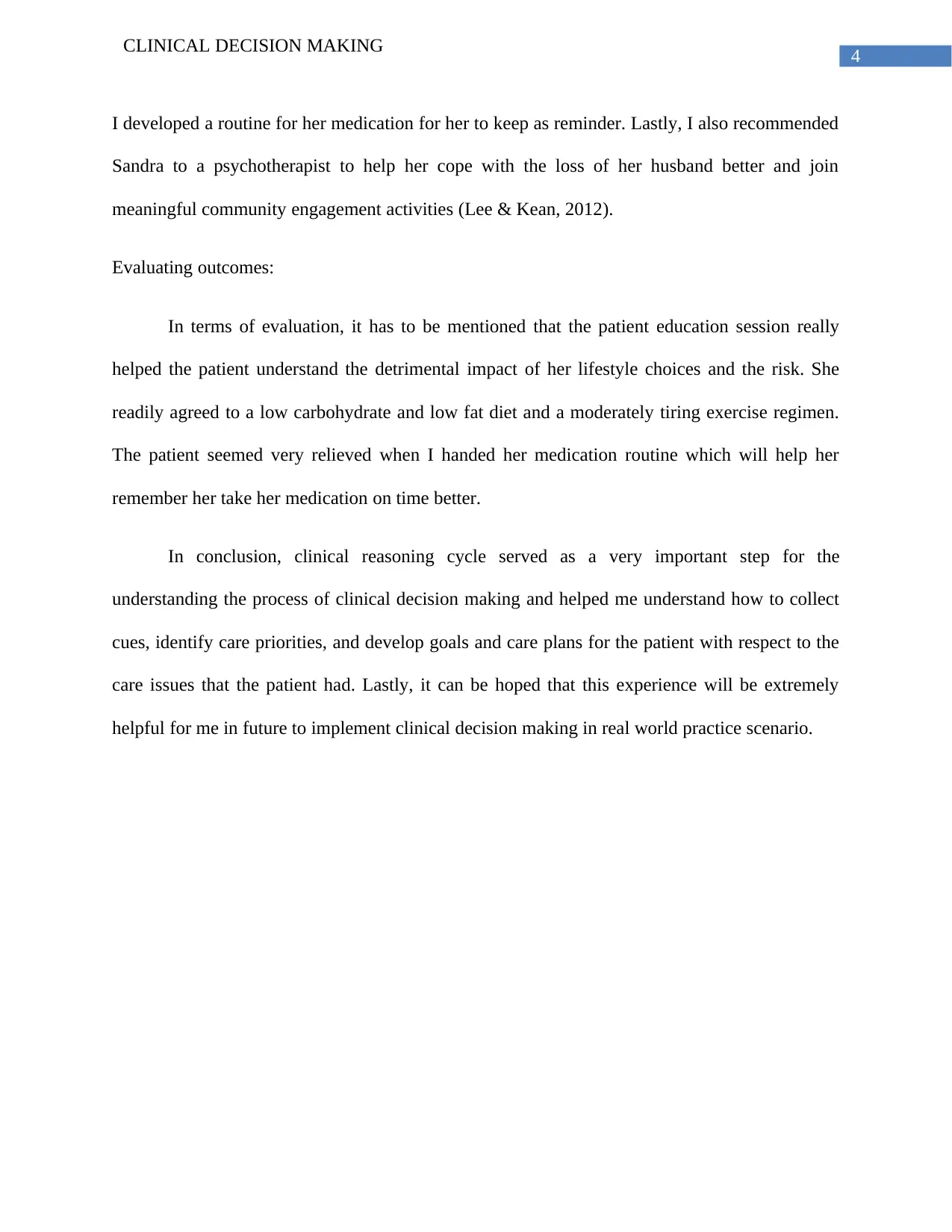
4
CLINICAL DECISION MAKING
I developed a routine for her medication for her to keep as reminder. Lastly, I also recommended
Sandra to a psychotherapist to help her cope with the loss of her husband better and join
meaningful community engagement activities (Lee & Kean, 2012).
Evaluating outcomes:
In terms of evaluation, it has to be mentioned that the patient education session really
helped the patient understand the detrimental impact of her lifestyle choices and the risk. She
readily agreed to a low carbohydrate and low fat diet and a moderately tiring exercise regimen.
The patient seemed very relieved when I handed her medication routine which will help her
remember her take her medication on time better.
In conclusion, clinical reasoning cycle served as a very important step for the
understanding the process of clinical decision making and helped me understand how to collect
cues, identify care priorities, and develop goals and care plans for the patient with respect to the
care issues that the patient had. Lastly, it can be hoped that this experience will be extremely
helpful for me in future to implement clinical decision making in real world practice scenario.
CLINICAL DECISION MAKING
I developed a routine for her medication for her to keep as reminder. Lastly, I also recommended
Sandra to a psychotherapist to help her cope with the loss of her husband better and join
meaningful community engagement activities (Lee & Kean, 2012).
Evaluating outcomes:
In terms of evaluation, it has to be mentioned that the patient education session really
helped the patient understand the detrimental impact of her lifestyle choices and the risk. She
readily agreed to a low carbohydrate and low fat diet and a moderately tiring exercise regimen.
The patient seemed very relieved when I handed her medication routine which will help her
remember her take her medication on time better.
In conclusion, clinical reasoning cycle served as a very important step for the
understanding the process of clinical decision making and helped me understand how to collect
cues, identify care priorities, and develop goals and care plans for the patient with respect to the
care issues that the patient had. Lastly, it can be hoped that this experience will be extremely
helpful for me in future to implement clinical decision making in real world practice scenario.
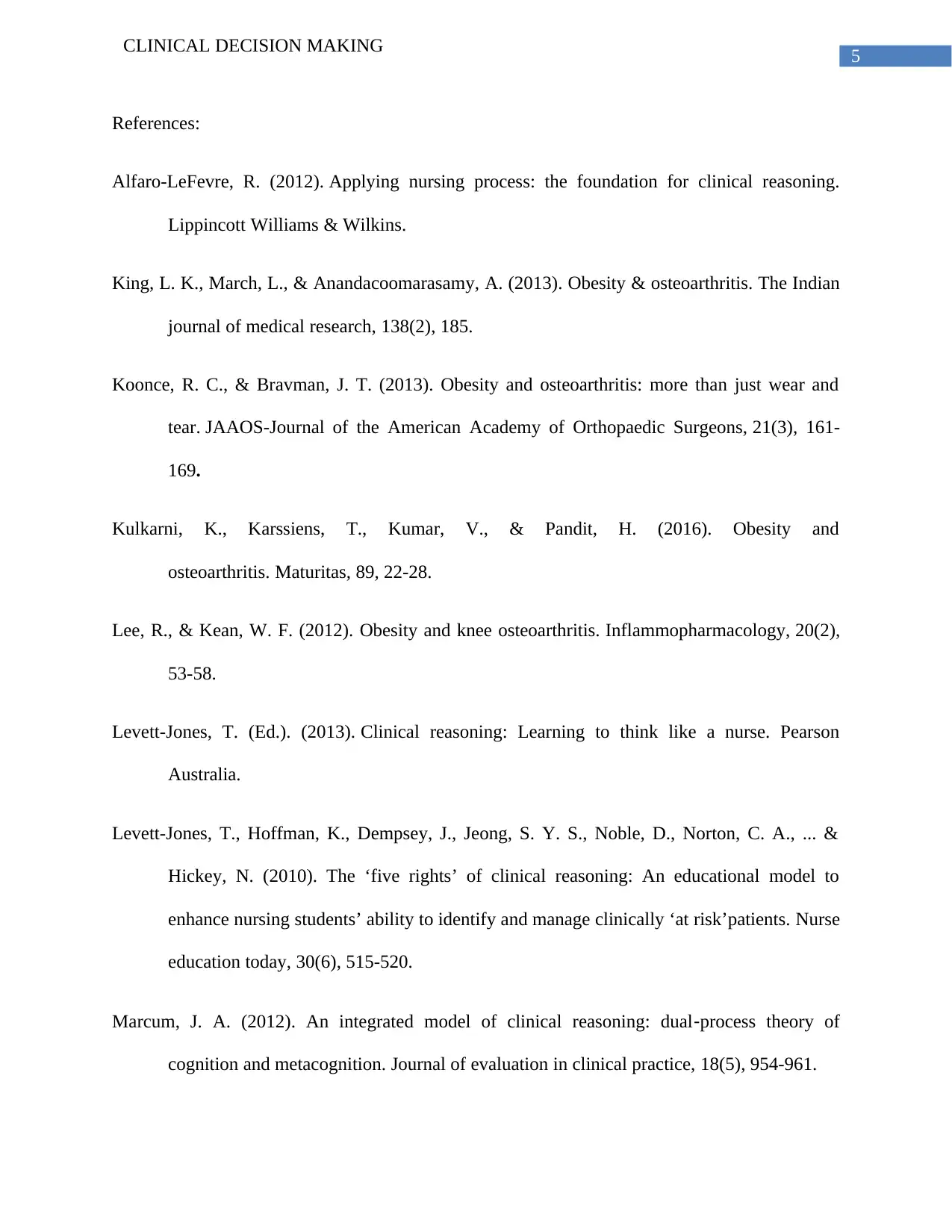
5
CLINICAL DECISION MAKING
References:
Alfaro-LeFevre, R. (2012). Applying nursing process: the foundation for clinical reasoning.
Lippincott Williams & Wilkins.
King, L. K., March, L., & Anandacoomarasamy, A. (2013). Obesity & osteoarthritis. The Indian
journal of medical research, 138(2), 185.
Koonce, R. C., & Bravman, J. T. (2013). Obesity and osteoarthritis: more than just wear and
tear. JAAOS-Journal of the American Academy of Orthopaedic Surgeons, 21(3), 161-
169.
Kulkarni, K., Karssiens, T., Kumar, V., & Pandit, H. (2016). Obesity and
osteoarthritis. Maturitas, 89, 22-28.
Lee, R., & Kean, W. F. (2012). Obesity and knee osteoarthritis. Inflammopharmacology, 20(2),
53-58.
Levett-Jones, T. (Ed.). (2013). Clinical reasoning: Learning to think like a nurse. Pearson
Australia.
Levett-Jones, T., Hoffman, K., Dempsey, J., Jeong, S. Y. S., Noble, D., Norton, C. A., ... &
Hickey, N. (2010). The ‘five rights’ of clinical reasoning: An educational model to
enhance nursing students’ ability to identify and manage clinically ‘at risk’patients. Nurse
education today, 30(6), 515-520.
Marcum, J. A. (2012). An integrated model of clinical reasoning: dual‐process theory of
cognition and metacognition. Journal of evaluation in clinical practice, 18(5), 954-961.
CLINICAL DECISION MAKING
References:
Alfaro-LeFevre, R. (2012). Applying nursing process: the foundation for clinical reasoning.
Lippincott Williams & Wilkins.
King, L. K., March, L., & Anandacoomarasamy, A. (2013). Obesity & osteoarthritis. The Indian
journal of medical research, 138(2), 185.
Koonce, R. C., & Bravman, J. T. (2013). Obesity and osteoarthritis: more than just wear and
tear. JAAOS-Journal of the American Academy of Orthopaedic Surgeons, 21(3), 161-
169.
Kulkarni, K., Karssiens, T., Kumar, V., & Pandit, H. (2016). Obesity and
osteoarthritis. Maturitas, 89, 22-28.
Lee, R., & Kean, W. F. (2012). Obesity and knee osteoarthritis. Inflammopharmacology, 20(2),
53-58.
Levett-Jones, T. (Ed.). (2013). Clinical reasoning: Learning to think like a nurse. Pearson
Australia.
Levett-Jones, T., Hoffman, K., Dempsey, J., Jeong, S. Y. S., Noble, D., Norton, C. A., ... &
Hickey, N. (2010). The ‘five rights’ of clinical reasoning: An educational model to
enhance nursing students’ ability to identify and manage clinically ‘at risk’patients. Nurse
education today, 30(6), 515-520.
Marcum, J. A. (2012). An integrated model of clinical reasoning: dual‐process theory of
cognition and metacognition. Journal of evaluation in clinical practice, 18(5), 954-961.
⊘ This is a preview!⊘
Do you want full access?
Subscribe today to unlock all pages.

Trusted by 1+ million students worldwide

6
CLINICAL DECISION MAKING
CLINICAL DECISION MAKING
1 out of 7
Related Documents
Your All-in-One AI-Powered Toolkit for Academic Success.
+13062052269
info@desklib.com
Available 24*7 on WhatsApp / Email
![[object Object]](/_next/static/media/star-bottom.7253800d.svg)
Unlock your academic potential
Copyright © 2020–2026 A2Z Services. All Rights Reserved. Developed and managed by ZUCOL.



